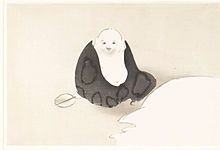Kamisaka Sekka

Kamisaka Sekka (神坂 雪佳, 1866–1942) was an important artistic figure in early twentieth-century Japan. Born in Kyoto to a samurai family, his talents for art and design were recognized early.[1] He eventually allied himself with the traditional Rinpa school of art. He is considered the last great proponent of this artistic tradition.[2] Sekka also worked in lacquer and in a variety of other media.

As traditional Japanese styles became unfashionable (such as Rinpa style), Japan implemented policies to promote the country's unique artistic style by upgrading the status of traditional artists who infused their craft with a dose of modernism. In 1901, Sekka was sent by the Japanese government to Glasgow where he was heavily influenced by Art Nouveau.[3] He sought to learn more about the Western attraction to Japonism, and which elements or facets of Japanese art would be more attractive to the West. Returning to Japan, he taught at the newly opened Kyoto Municipal School of Arts and Crafts, experimented with Western tastes, styles, and methods, and incorporated them into his otherwise traditional Japanese-style works.[3] While he sticks to traditional Japanese subject matter, and some elements of Rinpa painting, the overall effect is very Western and modern. He uses bright colors in large swaths, his images seeming on the verge of being patterns rather than proper pictures of a subject; the colors and patterns seem almost to "pop", giving the paintings an almost three-dimensional quality.
Momoyogusa
[edit]
Momoyogusa (A World of Things) is considered Sekka's woodblock-print masterpiece. The three-volume set was commissioned between 1909 and 1910 by the publishing firm Unsodo of Kyoto.[2] The Japanese name of the series can first be found in the eighth-century poetic text Collection of Ten Thousand Leaves (Man'yōshū), which refers to a multi-leaved autumnal herb (momoyogusa), possibly a chrysanthemum or wormwood.[3] The sixty image work displays a variety of landscapes, figures, classical themes, and innovative subjects, captured in a small space. They show Sekka's complete mastery of traditional Rimpa style, as well as combining his own approach and understanding of the innovations influencing Japan at the time.[2]
See also
[edit]References
[edit]- ^ Carpenter, John T.; N.Y.), Metropolitan Museum of Art (New York (2012). Designing Nature: The Rinpa Aesthetic in Japanese Art. Metropolitan Museum of Art. p. 36. ISBN 978-1-58839-471-2.
- ^ a b c Birmingham Museum of Art (2010). Birmingham Museum of Art: Guide to the Collection. London, UK: GILES. p. 50. ISBN 978-1-904832-77-5. Archived from the original on 2011-09-10. Retrieved 2011-06-09.
- ^ a b c "A World of Things by Kamisaka Sekka". The Art Institute of Chicago. April 14 – July 1, 2007. Archived from the original on October 12, 2008. Retrieved 2011-06-09.
External links
[edit]- 'Birds, flowers and figures on scattered fans' [1][permanent dead link] Collection of the Art Gallery of New South Wales.
